
 Weaving
Weaving
Weaving requires two different threads - the warp and the weft. The warp is long and strung from the front to the back of the
loom; the weft is laid from side to side during the weaving process. Looms can be large, several feet wide, or small enough
to be placed on a table. Cloth woven on a small loom can be sewn together to make a larger piece.
- The warp is long, runs from the front of the loom to the back, and is wound around horizontal wooden bars at the front
and back. These bars turn, to wind the warp at the front end or unwind the warp at the back, by using a simple notched
grip attached to the ends of the bars.
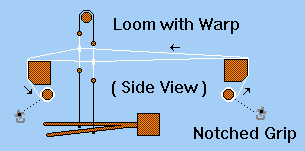
- The warp is strung by winding a continuous thread around pegs on a warp frame. Wind the thread back and forth
several times, creating several warp threads at one time, and then grip the bunch on both ends and transfer the warp
lengths to the loom frame. This is done repeatedly until the warp is as wide as the loom or as wide as desired. Make
the warp as long as possible, as the very front and back of the warp can never be woven and become waste or fringe.
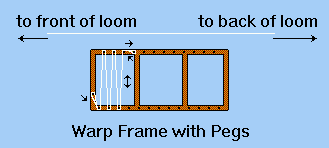
- The warp threads on the loom are threaded through heddles, which are also made of string or thread. A heddle is in
essence a small string loop inside a larger string loop, with the small loop in the middle to hold a warp thread so it can
be raised or lowered during the weaving process. The heddles are made on a heddle frame composed of three nails on
a board, the top loop tied above the middle nail, then below the middle nail, then below the bottom nail.
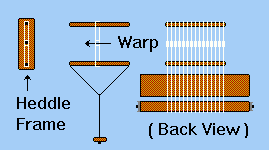
- The warp threads are strung through the heddles in the two heddle racks so that the odd warp threads go through the
heddles on one rack, and the even warp threads go through the heddles on the second rack. Then, by pressing one tread
or the other, the warp threads are raised and lowered by a pulley action, creating a criss-cross that secures the weft
threads passed back and forth across the warp.

- The weft threads are wound onto a bobbin, a metal rod, that is passed back and forth across the warp threads inside a
shuttle, as though they were sailing across the warp threads inside a tiny boat. The shuttle is a size that can be held in
the hand, longer than wide, and the wood is smoothed to avoid snagging during the weaving process. The shuttle has a
rectangle cut from the center where the filled bobbin is placed. The metal rod of the bobbin is held in place by notches
at the ends of this hole. A slit is cut at the side where the weft threads unwind.
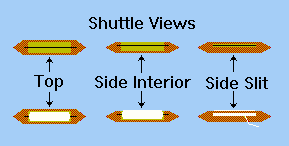
- After the shuttle is passed and the weft thread pulled so there is no slack, the beater bar is pulled forward to tap the
weft snug against the criss-cross of the warp threads. Then the beater bar is dropped back, away from the weaver, and
the warp threads reversed by the heddle pulley action controlled by the foot treads. The beater bar has a thin wire or
reed to go between each warp thread, and is not used with force but a gentle tapping action.
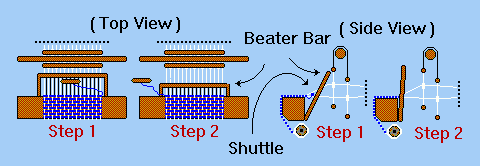
- Different patterns can be woven into the material by alternating colors in the warp thread and using a number of
shuttles - a checkerboard by alternating groups of red and white warp threads and also alternating groups red and white
weft threads. The edge of the material should be kept trim, so the material won't unravel, and when the material is
removed from the loom the warp threads are tied on both ends and can be left as a fringe or woven back into the
material with a needle to secure them.

Authored by Nancy.



![]()






